Limits to Economic Growth - Challenge and Choices
Economics / Global Economy Nov 22, 2015 - 03:31 PM GMTBy: Nicole_Foss
 Nicole Foss: After more than 30 years of exponential growth, gargantuan resource demand and increasingly frenetic consumption, we have now reached, or are reaching, an array of limits to growth. During our long, debt-fuelled boom, we reached out spatially through globalisation to monetise as much global production as possible, in order to facilitate the efficient transfer of wealth from the global periphery to its economic heartland.
Nicole Foss: After more than 30 years of exponential growth, gargantuan resource demand and increasingly frenetic consumption, we have now reached, or are reaching, an array of limits to growth. During our long, debt-fuelled boom, we reached out spatially through globalisation to monetise as much global production as possible, in order to facilitate the efficient transfer of wealth from the global periphery to its economic heartland.
We also, through the profligate use of credit and debt, reached forward in time to borrow from the future in order to stage an orgy of consumption in the present. This spectacularly successful modern form of economic imperialism delivered unprecedented wealth concentration, the like of which previous imperial structures could not have dreamed of attaining.
We are facing limits in terms of finance, energy, water, soil fertility, food web integrity on both land and sea, biodiversity, carrying capacity and the environment’s ability to absorb waste streams, among others. All of these factors, and the interactions between them, constitute parts of the reality jigsaw which we have been developing here at the Automatic Earth for the past eight years. Although we focus primarily on finance, as this is the first limit many will face, all limiting factors, and their relative timeframes, are vital to an understanding of the way the next several decades can be expected to play out.
This understanding of the big picture is crucial, but even more important is the ability to apply the knowledge in practice. This involves working through a complex decision tree process, spanning the assessment of strengths, weaknesses, opportunities, vulnerabilities and potential courses of action at different scales, from the individual to the regional. Our latest Automatic Earth video offering – Challenge and Choices – is designed to offer guidance in working through this process.
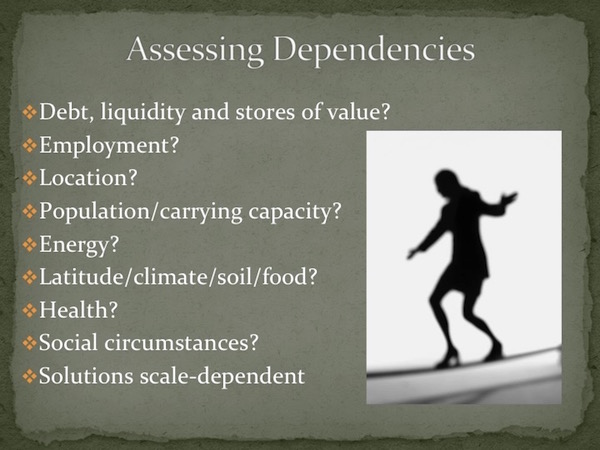
The video is divided into chapters, beginning in Chapter 1 with a broad overview of the limits to growth scenario, expanded to include a wider range of factors than we generally focus on at the Automatic Earth. The elements to be considered in an assessment of dependencies, or vulnerabilities, naturally lend themselves to actions at different scales. A vulnerability assessment typically begins with personal or family circumstances, hence the initial segments of the presentation focus on these aspects, beginning in Chapter 2 with financial circumstances.
As we have discussed many times at the Automatic Earth, we are facing the bursting of a major financial bubble and this is leading us directly into a state of economic depression, where people can expect many of the assumptions upon which their lives have been built to be invalidated in a short space of time. Such a period is characterised by high unemployment, sharply rising interest rates, taxes and rates (property taxes), falling incomes, cuts to benefits and entitlements, falling asset prices, major government spending cuts and increasingly aggressive debt collection, among other factors.
Being aware of these risks in advance allows for people to minimise the impact. The factors under consideration in our new presentation include leverage (what you owe compared to what your own), consequent interest rate risk, the potential for bankruptcy protection, margin call potential, access to and control over liquidity reserves, personal stores of value, risk management strategies and extended family issues.
The security of both liquidity and of stores of value will be extremely important, and extremely challenging. During a liquidity crunch, there will be very little money in circulation, leading to very little economic activity, and under such circumstances, cash will be exceptionally important. Managing risks to liquidity (cash) makes the difference between being at the mercy of changing circumstances and having the freedom of action to respond to both opportunities and threats as they develop. It is therefore important to avoid the large risks beyond one’s own control that are associated with assets inside the financial system, while learning to manage the risks associated with being outside of it.
Income streams will vary greatly in terms of reliability in economically contractionary times, given that the quantity of money available will decline sharply, and money in circulation will diminish even more quickly as increasingly risk-averse people cease spending and hold on to cash reserves, if they are lucky enough to have some. Many current employment opportunities will dry up or cease to exist entirely, and holding on to such a position now may mean being economically stranded at a time when available employment niches are much reduced in scope and already filled to capacity.
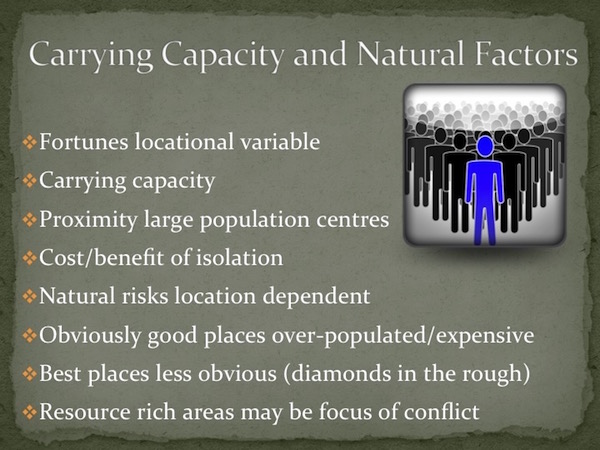
In an ideal world, one would therefore seek to be positioned in advance in a trade or profession likely to continue to deliver an income stream even in times when disposable income will be very scarce. This involves looking at one’s own skill set and personal inclinations, and moving towards using these to provide essential goods or services locally. Either employment or self-employment can be viable options, with running one’s own business raising many additional considerations. Although the complications may be greater, so is the potential for adding usefully to the economic and social fabric of one’s local environment.
Major decisions for everyone surround the issue of shelter – the appropriate form, the means of obtaining it and where it is located. The question of ownership versus renting deserves much greater consideration than most people allow for, given the degree of leverage involved in most cases. Property is drastically over-valued in many locations.
Purchasing property will not necessarily be the right decision, especially under circumstances where the financial value of the asset is set to fall substantially, but the debt will remain the same, leading to a rash of negative equity. Since the burden the debt represents will grow as both interest rates and unemployment rise, and social safety nets are withdrawn, there is a considerable incentive to remain debt-free through renting rather than ownership. Renting also allows for valuable flexibility as to location.
Chapter 3 goes into considerable detail as to the advantages and disadvantages of different types of locations – urban, rural, suburban, small town and intentional community. It is important to realise that the status quo is an active choice, not just a default option, and it may well not be a good one for one’s circumstances. All alternative options, including the status quo, should be thought through in order to avoid becoming stuck in the wrong place, facing risks that might have been avoidable. Becoming stuck is a very real risk under depression conditions, when freedom of action is likely to be very sharply limited, hence positioning in advance in highly advantageous.
The best choice will vary for different people with different circumstances, so there is no one right answer as to the best place, or set of circumstances, to be located. Each option is presented with suggestions as to which might suit what kind of individuals and families, and case-studies are provided as to workable approaches in each different environment. There are many quite inspiring examples from around the world to choose from.
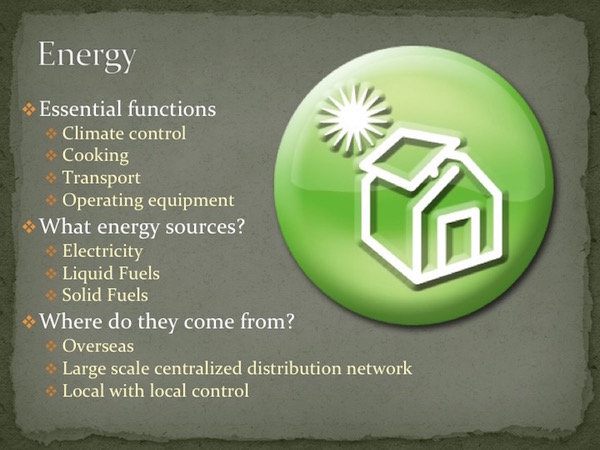
In choosing a good location, carrying capacity and natural factors such as local resource availability need to be taken into account. These factors are considered in Chapter 4. For instance, a reliable water supply of predictable quality will be of particular importance, and one might not be able to rely on current sources that may be vulnerable under depression conditions. Similarly the potential impact of natural threats – wildfires, flooding, drought, earthquakes, cyclones, blizzards, extreme cold – needs to be understood as these are highly variable and represent a wide range of risk scenarios. The risks one feels comfortable with, or can tolerate, manage or mitigate, will be individual choices.
The most obviously good places are probably already over-crowded and expensive, whereas more marginal places may well have been overlooked and may represent both much better financial value and a greater range of opportunities. A given area can only support a certain number of people, and those limits can only be circumvented if large-scale trade is feasible and affordable energy readily available.
As we have pointed out at the Automatic Earth many times before, trade is very vulnerable when the credit it relies on dries up, meaning that economically contractionary times typically lead to trade collapses. At that point, local circumstances such as carrying capacity for a given local resource base become paramount. However, living close to a rich resource base is not necessarily the answer. One only has to look at the resource-rich geopolitical hotspots in the world to know that living on top of coveted resources is not necessarily an advantage.
Energy supply will be a major issue in many, if not most, regions. As we have noted many times here at the Automatic Earth, gross energy production is flat to falling globally, and the average energy profit ratio (energy returned on energy invested) is falling sharply. A greater and greater percentage of energy produced is being reinvested in energy production, leaving less and less to serve all society’s other purposes.

Both unconventional oil and gas and most forms of ‘renewable’ energy have low energy profit ratios and are also critically dependent on conventional oil gas gas production to enable them to be developed at all. As such they represent nothing more than an extension of the high energy profit ratio conventional fossil fuel era that we are now moving beyond. Being capital intensive as well as trade-dependent, they also depend on the continued expansion of the financial bubble, but this is on the verge of implosion. The future will be one of far less energy available, and consequently much reduced socio-economic complexity.
Families would do well to take a hard look at their energy-dependent essential functions (such as cooking, climate control, transport, and equipment operation), and think about what energy sources are required to fulfil these functions, what vulnerabilities different sources of supply may be subject to, whether each function is truly essential, and whether there may be more than one way to perform truly essential functions. One may require specifically electricity, liquid fuel or solid fuel, but there may be some capacity for substitution, perhaps with some additional or modified equipment.
The energy required may come from overseas or may require a large-scale centralised distribution system. Both of these represent significant threats to continued supply under conditions of credit contraction, trade collapse and reduced socio-economic complexity. Conversely, local energy sources which can be relatively simply obtained are a far more secure source of supply. Local dependency creates considerably less vulnerability, hence moving over to local supply in advance of supply problems would be advisable. Redefining essentials and moving away from requiring external energy sources would reduce vulnerability even further.
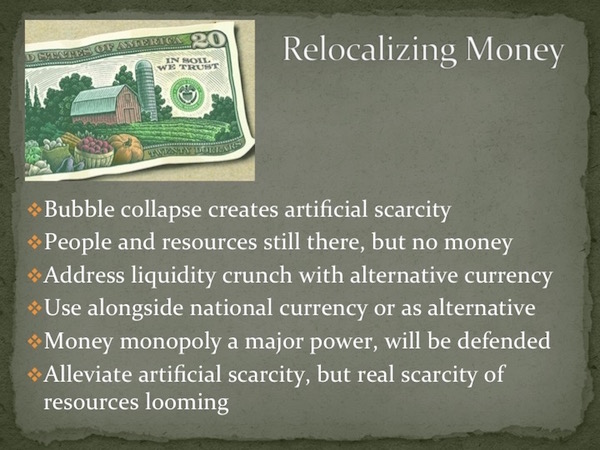
The local climate will determine how many aspects of life play out in practice, notably energy demand for climate control. Climate not requiring external energy inputs would eliminate a substantial dependency, but only a minority would have the choice to live in such a place. For the rest, thinking through how truly essential climate control is, and how this might be achieved in a low energy environment, will be important.
The development of tolerance for a wider range of indoor temperatures is likely to be necessary. Climate and water availability will, of course, determine what food can be grown locally, and in the sharp reduction of trade will reduce the potential for bringing food in from elsewhere. Relative proximity to the poles determines growing season, and is therefore a strong influence on the balance between plant and animal foodstuffs under a locavore scenario.
Health, healthcare care, social circumstances and political culture are also important factors in determining a good location for a given individual or family group. They are highly variable now, and can be expected to become more so as regions become more isolated with reduced trade. Human connections will grow greatly in importance in difficult times, hence being in a location where one is socially and culturally embedded can be expected to make a substantial difference to family fortunes. Any contemplation of relocation must take these aspects into account as they may ultimately matter more than physical circumstances. These factors are covered in depth in the Challenge and Choices presentation.
The scale of the community in which a family is socially involved will determine the range of choices available beyond the scale of individuals and families themselves. Isolation limits the range of options considerably, meaning that attempting to ‘go it alone’ is not advisable. Communities, whether urban, suburban, small town, village or rural, all offer the advantages of being able to work with others for mutual benefit. Chapter 5 is devoted to exploring the options available at larger scale, beginning with emphasis on community scale potential for pooling resources and building valuable social capital.
Relationships of trust are the foundation of society, enabling collective human endeavours to function. Building them in advance of difficult times creates a critical advantage, allowing existing constructive initiatives to flourish and new ones to gain traction rapidly once the need for them becomes clear. A range of examples of communal possibilities is given in the presentation, including community hubs, maker spaces, community projects, local network building and peer to peer coordination and funding activities.
Several are then discussed in greater depth, notably those in the economic sphere which will be necessary to navigate a period of liquidity crunch. These include time banking, savings pools, alternative currencies, alternative trading arrangements and the slow money movement. These are initiatives reducing the dependence on the existing monetary system, thereby reducing exposure to the risk of that system being disrupted.
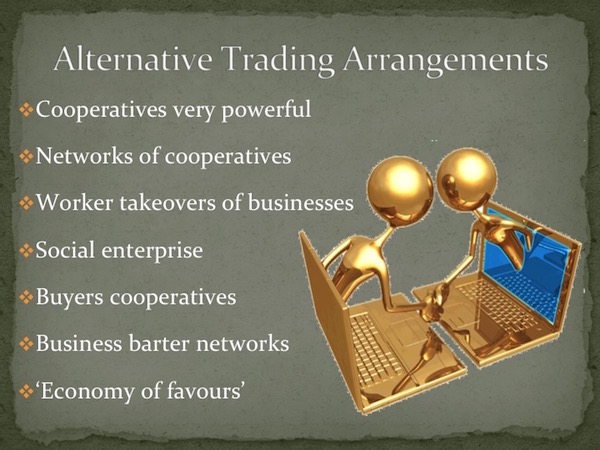
Periods of economic depression create a situation of artificial scarcity, where a society has all the resources it had before, but due to the lack of money in circulation, can no longer make use of them. As those who lived through the great depression of the 1930s said – “We had everything but money”. Finance represents the operating system for our societies, and when that system crashes, it it necessary to ride out the acute phase of the crunch, and then to reboot the system into a more workable form. The initial phase creates an urgent need to substitute for the missing liquidity in the larger system with alternative forms of liquidity at the local level, in other words to relocalise finance in order to ride out the period of hardship.
Such systems emerge spontaneously at times and in places where economic depressions have been or are now in force, for instance Austria during the 1930s, Argentina following 2001 or Greece today. However, they can be initiated in advance, functioning in parallel with the larger system, and then are well positioned to stand more or less alone when the need arises. Examples of alternative currencies functioning under normal circumstances and under depression conditions are discussed in Challenge and Choices.
The need for financial relocalisation is but one aspect of the general need for much greater decentralisation. The contraction of the trust horizon during times of economic and financial contraction results in the need for all manner of activities, very much including finance, to operate at much smaller scale in order to function. Trust determines effective organizational scale, hence in contractionary times, working within the trust horizon implies working at substantially smaller scale. Governance mechanisms will be no exception.
Dependence on larger scale organizations to deliver essential goods and services, or to maintain a functioning socio-economic system, will represent a considerable vulnerability at a time when those entities are ceasing to be able to perform the functions for which they currently hold responsibility. Over time those responsibilities will come to vest in whichever organizations are positioned in practice to assume them, whether or not such organizations have the legal responsibility to do so.
Smaller scale governing institutions and regulatory mechanisms, which have been substantially disempowered in recent years, can therefore expect to inherit greater responsibility in the future. Being informed and well-positioned in advance to step into any power vacuum once it appears will be advantageous.
Centralised systems often struggle already to deliver what they are supposed to, hence decentralisation initiatives are already underway in many fields. These are commonly opposed by a top-down system critically dependent on continued growth, and the increasingly complete buy-in required to maintain it. It is therefore becoming increasingly difficult to opt out, even as doing so is coming to make more and more sense because the cost burden associated with the larger system is increasingly disproportionate to the benefits it is able to deliver.
In many ways the essentials can be provided independently at far lower cost, thanks to the absence of large and complex bureaucracies to support. This makes them a threat to a larger system reliant on holding hostage the provision of essentials by closing off independent options. Trying to achieve independence in any sphere therefore faces obstacles which make it more difficult than it should be, but it will be necessary to move in that direction in any case.
The existing level of socio-economic complexity allowing larger scale systems to function is itself dependent on trust, political legitimacy, cheap money and cheap energy, all of which are threatened in a limits to growth scenario. The future will be simpler and more local whether we like it or not, so we must position ourselves for that future. In doing so we generate resilience – the ability to cope under a wide range of circumstances, to bounce back from system shocks and to thrive in the meantime. This capacity is what working through the limits to growth decision tree process is capable of establishing.
Challenge and Choices provides the basis for being proactive at both the individual and collective levels, allowing us to face the approaching limits and navigate a near future fraught with risk and uncertainty. Challenging circumstances are much less daunting when equipped with information, analysis and the tools required to adapt to a changing big picture. We can replace a destructive mindset with a constructive one grounded in a solid sense of purpose, replacing fear of the unknown with empowerment.

Nicole Foss
To purchase the 3-hour video download of Challenge and Choices, go to our store. Click this image to get there:

By Nicole Foss
Website: http://theautomaticearth.com (provides unique analysis of economics, finance, politics and social dynamics in the context of Complexity Theory)
© 2015 Copyright Nicole Foss - All Rights Reserved Disclaimer: The above is a matter of opinion provided for general information purposes only and is not intended as investment advice. Information and analysis above are derived from sources and utilising methods believed to be reliable, but we cannot accept responsibility for any losses you may incur as a result of this analysis. Individuals should consult with their personal financial advisors.
© 2005-2022 http://www.MarketOracle.co.uk - The Market Oracle is a FREE Daily Financial Markets Analysis & Forecasting online publication.



